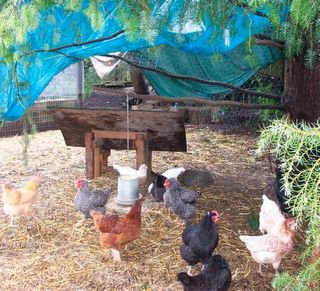Note: This is a story that may disturb some children and adults.We reported several weeks ago, that Naughty Mary, our New Hampshire had gone to live in the country with our friend's Joe & Shelly. Joe had also acquired a rooster from friends living close by, a lovely Auracana named Mr. May. Mary and Mr. May were very happy in their new environment. Things had been going well, until a careless neighbor living close to Joe stopped monitoring his dogs. One of the dogs began making visits to Joe's property to chase and sometimes catch hens. Joe approached his neighbor, and for whatever reason the neighbor continued to be careless about monitoring his dogs.
One day Joe heard a ruckus from the coop, and thought perhaps Mr. May was overly interested in a hen. He went out to chase Mr. May away from the hen, and when he entered the coop he was met with a scene of carnage--the neighbor's dog had somehow gotten into the coop, and a door closed behind him. He had already killed 2 hens, when Joe arrived, and Mr. May was putting up the battle of his life.
Joe removed the dog from the coop and then did what Oregon law entitles him to do with dogs who kill livestock--he put the dog down. Then he tended to Mr. May's wounds and buried his dead hens. Naughty Mary was one of these. Joe's flock had been reduced to Mr. May and one remaining hen.
This is a painful story to tell, but we are hopeful that dog owners reading this will take extra care with their dogs--and realize that in many states when an unattended dog kills livestock or even other pets, these dogs can legally be put down. Additionally, for chicken owners--fencing, fencing, fencing! Make sure your fencing is substantial and strong enough to withstand a stray dog entering your yard.
There is an unusual positive note out of all this--one of the reasons Mr. May had gone to live with Joe is that he had become way too aggressive for the urban environment. Joe has reported since the incident where Joe put down the dog, Mr. May seems to regard Joe as something akin to "Top Rooster"--but has also noticed that Joe doesn't seem to have any interest in the hens. Mr. May no longer charges Joe, and Mr. May seems to have developed an affinity for the "Top Rooster".


















